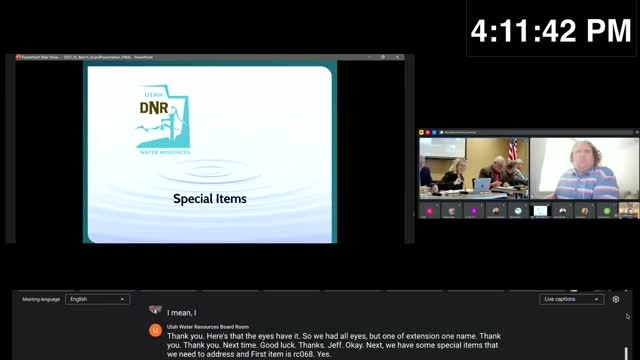Board allocates $256K for Lindsay Bennett Dam safety upgrades and project completion
March 22, 2025 | Natural Resources Department, Utah Environment, State Agencies, Organizations, Utah Executive Branch, Utah
This article was created by AI summarizing key points discussed. AI makes mistakes, so for full details and context, please refer to the video of the full meeting. Please report any errors so we can fix them. Report an error »

In a recent meeting of the Utah Water Resources Board, critical discussions unfolded regarding two significant water management projects aimed at enhancing safety and efficiency in local irrigation systems. The atmosphere was charged with urgency as board members and project representatives gathered to address pressing water resource challenges.
The first project focused on the Twin Creek Special Service District, specifically the Lindsay Bennett Dam. Ethan, a representative for the district, presented a request for additional funding to complete essential upgrades to the dam's outlet. Initially estimated at $744,000, the total project cost has now risen to approximately $930,000 due to unforeseen complications, including significant issues with the outlet's structure. The board unanimously approved an additional $256,000 to ensure the project meets safety standards, reflecting the importance of maintaining infrastructure that serves both culinary and secondary water needs for local residents.
Max Covey, representing the Twin Creek district, expressed gratitude for the board's support and highlighted the urgency of the project, especially in light of the region's water supply challenges. With the project nearing completion, Covey noted that the dam is now in the filling process, allowing for better water storage as the summer approaches.
The second project discussed was presented by Russell, representing the Dry Gulch Irrigation Company. This initiative aims to address water loss in the existing Perry Page pipeline system, which serves over 3,120 acres of agricultural land. The proposed phase two project seeks to replace outdated standpipes with pressure-reducing valve stations, a move expected to conserve approximately 1,080 acre-feet of water annually. The board considered a funding request of $492,000, which would cover 77% of the project costs, but decided to postpone the commitment due to unresolved easement issues.
Both discussions underscored the board's commitment to improving water management in Utah, particularly in light of ongoing drought conditions that have intensified the need for efficient irrigation systems. As the board navigates these challenges, the outcomes of these projects will play a crucial role in ensuring sustainable water resources for the communities they serve.
The first project focused on the Twin Creek Special Service District, specifically the Lindsay Bennett Dam. Ethan, a representative for the district, presented a request for additional funding to complete essential upgrades to the dam's outlet. Initially estimated at $744,000, the total project cost has now risen to approximately $930,000 due to unforeseen complications, including significant issues with the outlet's structure. The board unanimously approved an additional $256,000 to ensure the project meets safety standards, reflecting the importance of maintaining infrastructure that serves both culinary and secondary water needs for local residents.
Max Covey, representing the Twin Creek district, expressed gratitude for the board's support and highlighted the urgency of the project, especially in light of the region's water supply challenges. With the project nearing completion, Covey noted that the dam is now in the filling process, allowing for better water storage as the summer approaches.
The second project discussed was presented by Russell, representing the Dry Gulch Irrigation Company. This initiative aims to address water loss in the existing Perry Page pipeline system, which serves over 3,120 acres of agricultural land. The proposed phase two project seeks to replace outdated standpipes with pressure-reducing valve stations, a move expected to conserve approximately 1,080 acre-feet of water annually. The board considered a funding request of $492,000, which would cover 77% of the project costs, but decided to postpone the commitment due to unresolved easement issues.
Both discussions underscored the board's commitment to improving water management in Utah, particularly in light of ongoing drought conditions that have intensified the need for efficient irrigation systems. As the board navigates these challenges, the outcomes of these projects will play a crucial role in ensuring sustainable water resources for the communities they serve.
View full meeting
This article is based on a recent meeting—watch the full video and explore the complete transcript for deeper insights into the discussion.
View full meeting

